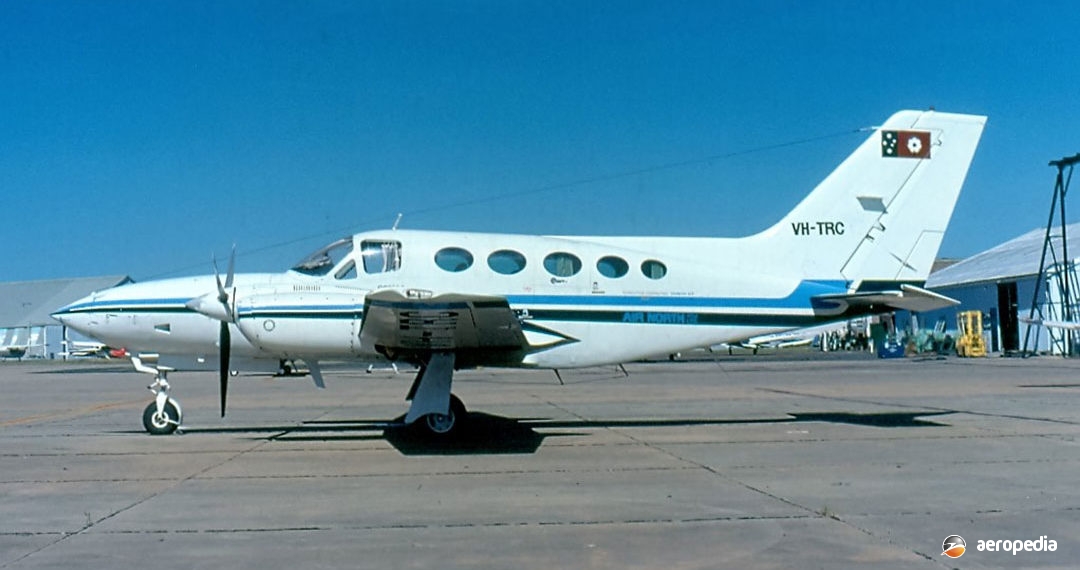Photograph:
Cessna 421C Golden Eagle VH-TRC (c/n 421C-0079) at Bankstown, NSW in March 1981 (David C Eyre)
Country of origin:
United States of America
Description:
Business and executive aircraft
Power Plant:
Two 280 kw (375 hp) Continental GTSIO-520-L six-cylinder geared horizontally-opposed fuel-injected air-cooled engines with turbochargers
Specifications:
- Wingspan: 12.53 m (41 ft 1½ in)
- Length: 11.09 m (36 ft 4½ in)
- Height: 3.49 m (11 ft 5½ in)
- Wing area: 19.97 m² (215 sq ft)
- Max speed at 6,096 m (20,000 ft): 474 km/h (295 mph)
- Cruising speed at 7,620 m (25,000 ft): 445 km/h (276 mph)
- Initial rate of climb: 588 m/min (1,940 ft/min)
- Service ceiling: 9,205 m (30,200 ft)
- Single-engine ceiling: 4,542 m (14,900 ft)
- Take-off distance over 15 m (50 ft) obstacle: 708 m (2,323 ft)
- Landing distance over 15 m (50 ft) obstacle: 699 m (2,293 ft)
- Range with standard fuel at 7,620 m at 75% power: 1,740 km (1,080 miles)
- Range with max fuel at 7,620 m (25,000 ft) at 75% power: 2,755 km (1,712 miles)
- Empty weight: 2,041 kg (4,501 lb)
- Loaded weight: 3,379 kg (7,450 lb)
History:
Designed as a replacement for the Cessna 411, the prototype of the Model 421 was flown for the first time on 14 October 1965. The main differences between the Models 421 and 411 were the up-rated engines and pressurised cabin of the new model, thus permitting it to cruise at higher altitudes. The pressurisation system was a standard type which operated off the engine turbochargers, and was not otherwise mechanically or hydraulically linked to the power plants. The system maintained sea level pressure inside the cabin up to 2,743 m (9,000 ft). Type approval was received on 1 May 1967, and deliveries of production aircraft commenced in June of that year.
As with other Cessna aircraft, progressive improvements were made from time to time, and letters were added to the model number as major changes were made. The first improvement to the basic Model 421 was the Model 421B Golden Eagle business and executive aircraft, which could be fitted with ten seats for the third-level/commuter airline market.
In 1976 the Model 421C was introduced with a new wing from the nacelles outboard containing integral fuel tanks, thus dispensing with the wingtip tanks that had been fitted previously. The new wing used metal-to-metal bonding to achieve a smooth finish. The turbochargers were modified to increase critical altitude and undercarriage retraction was changed to a hydraulic system instead of electric.
A further development was introduced in 1968, this being the Model 414. It was intended that the new Model 414 would be marketed alongside the Model 421. The Golden Eagle was available in a basic model, in Golden Eagle II form with a package of 11 optional items of equipment plus IFR avionics factory-installed, or as the Model 421 Executive Commuter with a special interior. Engines were the Continental GTSIO-520-H or L geared units driving 2.29 m (7 ft 6 in) fully-feathering propellers. Standard fuel capacity was 808 litres (178 Imp gals).
By 1976 the Golden Eagle series was established as the best seller in its class and in its boom year 200 examples left the production line in Wichita, Kansas, Even in 1975, when aircraft sales were down, 150 examples were delivered. The Model 421C was first displayed at the National Business Aircraft Association Convention (NBAA) in October 1975 and when production was suspended of the 421 series in 1985 1,901 examples had been completed.
The Model 421 was chosen for the communications role by the RNZAF, three operating with No 42 Squadron: NZ7923 (c/n 421C-1023) changed to NZ7940 in 1981. It was retired and sold as ZK-FYX in 1991, later being exported to the United States as N678SW.
NZ7924 (c/n 421C-1024) had its serial changed in 1981 to NZ7941. It was sold as ZK-FYY in 1991 and exported to the United States as N432SW before going to Germany as D-IKST. It was lost in an accident on 28 April 2009.
NZ7925 (cn 421C-1025) also had its serial changed to NZ7942 in 1981. It served until 1991 when it was sold as ZK-FYZ. It was exported to the United States as N942SW in 1991, later going to Germany in 1992 as D-IGRB and returning to the United States in 1993 as N942SW.
These three Cessna 421 aircraft replaced de Havilland Devons in RNZAF service, operating from February 1981 until sold in 1991 as an economy measure.
More than 45 examples of the Cessna 421 series have been registered in this region.
Examples of the Cessna 400 series have been used by a number of air forces around the world over the years, operators including the Mexican Navy, Thai Air Force, Bolivian Navy, Malaysia, Paraguay, Venezuela National Guard, Royal Bahamas Defence Force, Dominican Air Force, Tanzanian People’s Defence Force, Turkish Army Aviation, Ivory Coast, Pakistan Army, etc.

